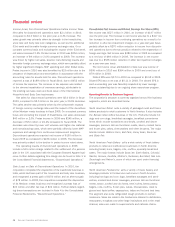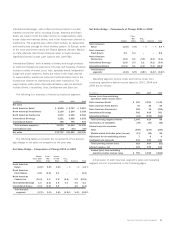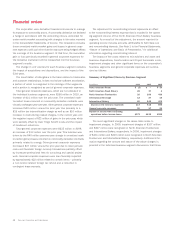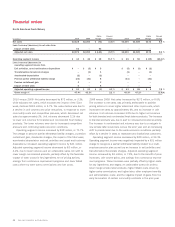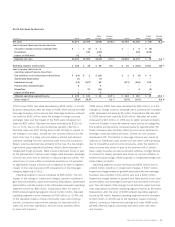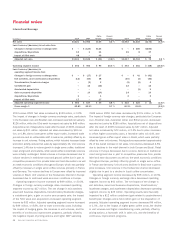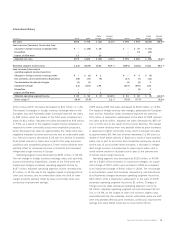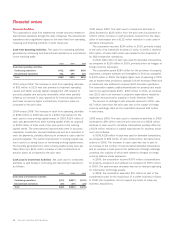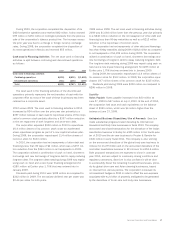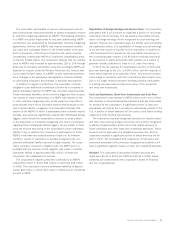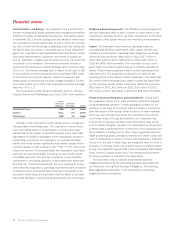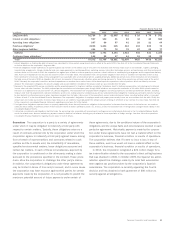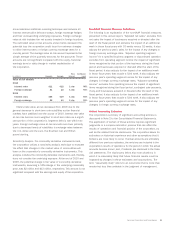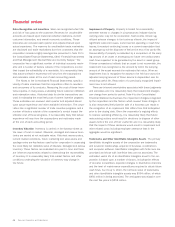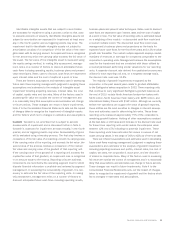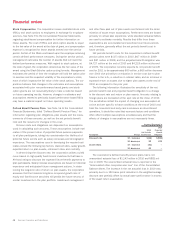Sara Lee 2010 Annual Report Download - page 40
Download and view the complete annual report
Please find page 40 of the 2010 Sara Lee annual report below. You can navigate through the pages in the report by either clicking on the pages listed below, or by using the keyword search tool below to find specific information within the annual report.38 Sara Lee Corporation and Subsidiaries
Including the impact of swaps, which are effective hedges and
convert the economic characteristics of the debt, the corporation’s
long-term debt and notes payable consist of 69.7% fixed-rate debt
as of July 3, 2010, as compared with 70.1% as of June 27, 2009.
The decrease in fixed-rate debt at the end of 2010 versus the end
of 2009 is due to the repayment of long-term fixed rate debt that
matured during the period. The corporation monitors the interest
rate environments in the geographic regions in which it operates
and modifies the components of its debt portfolio as necessary
to manage interest rate and foreign currency risks.
Pension Plans As shown in Note 16 to the Consolidated Financial
Statements, titled “Defined Benefit Pension Plans,” the funded
status of the corporation’s defined benefit pension plans is defined
as the amount the projected benefit obligation exceeds the plan
assets. The underfunded status of the plans is $530 million at
the end of fiscal 2010 as compared to $466 million at the end
of fiscal 2009.
The corporation expects to contribute approximately $110 million
of cash to its pension plans in 2011 as compared to $332 million
in 2010 and $306 million in 2009. The 2011 contributions are for
pension plans of continuing operations and pension plans where
the corporation has agreed to retain the pension liability after cer-
tain business dispositions were completed. The exact amount of
cash contributions made to pension plans in any year is dependent
upon a number of factors, including minimum funding requirements
in the jurisdictions in which the company operates, the timing of
cash tax benefits for amounts funded and arrangements made with
the trustees of certain foreign plans. As a result, the actual funding
in 2011 may be materially different from the estimate.
During 2006, the corporation entered into an agreement with
the plan trustee to fully fund certain U.K. pension obligations by
2015. The anticipated 2011 contributions reflect the amounts
agreed upon with the trustees of these U.K. plans. Under the
terms of this agreement, the corporation will make annual pension
contributions of 32 million British pounds to the U.K. plans through
2015. Subsequent to 2015, the corporation has agreed to keep
the U.K. plans fully funded in accordance with local funding stan-
dards. If at any time prior to January 1, 2016, Sara Lee Corporation
ceases having a credit rating equal to or greater than all three of
the following ratings, the annual pension funding of these U.K. plans
will increase by 20%: Standard & Poor’s minimum credit rating of
“BBB-,” Moody’s Investors Service minimum credit rating of “Baa3”
and FitchRatings minimum credit rating of “BBB -.” The corporation’s
credit ratings are currently above these levels and are discussed
below in this Liquidity section.
During 2010, Sara Lee announced a revised capital plan that
focuses on share repurchase, dividend pay-out and the funded
status of the company’s pension plans, while maintaining a solid
investment grade credit profile.
As part of this capital plan, the company plans to buy back $2.5
to $3 billion of shares of its common stock over a three-year period.
Through a $500 million accelerated share repurchase (ASR) program
that was announced in March 2010, which was completed in the
first quarter of 2011, Sara Lee bought back approximately 36 mil-
lion shares of common stock. Sara Lee plans to repurchase $1.0
to $1.5 billion of shares in fiscal 2011, of which $500 to $800 mil-
lion are expected to be repurchased in the remainder of calendar
year 2010. Approximately $2.5 billion remains authorized for share
repurchase by the board of directors, in addition to the 13.5 million
share authorization remaining under the prior program.
In addition, Sara Lee’s board of directors intends to maintain
and gradually increase the corporation’s current $0.44 per share
annualized dividend.
The previously announced $200 million voluntary cash contribution
to the company’s pension plans was made in the fourth quarter of
fiscal 2010.
The company continues to evaluate the best opportunities for
value creation and investment of cash, including potential acquisitions
or other investments in the company’s growth.
Debt The corporation’s total long-term debt decreased $50 million
in 2010, to $2,734 million at July 3, 2010. Long-term debt maturing
during 2010 of $25 million was repaid using cash on hand. A new
2-year financing arrangement for €300 million at 2.25% was entered
into in March 2010 that replaced previous Euribor financing held by
the corporation. The corporation’s total remaining long-term debt of
$2,734 million is due to be repaid as follows: $16 million in 2011,
$1,545 million in 2012, $532 million in 2013, $26 million in 2014,
$74 million in 2015 and $541 million thereafter. Debt obligations due
to mature in the next year are expected to be satisfied with cash on
hand, cash from operating activities or with additional borrowings.
From time to time, the corporation opportunistically may
repurchase or retire its outstanding debt through cash purchases
and/or exchanges for equity securities, in open market purchases,
privately negotiated transactions or otherwise. Such repurchases
or exchanges, if any, will depend on prevailing market conditions,
the corporation’s liquidity requirements, contractual restrictions
and other factors. The amounts involved could be material.
Financial review


